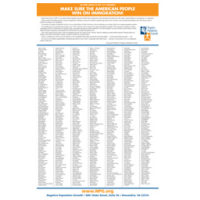NPG Immigration Fact Sheet: What You Need to Know
- Tracy Henke
- June 16, 2015
- NPG
- 0 Comments
NPG Immigration Fact Sheet:
What You Need to Know
With so many headlines about immigration – border security, unemployment, amnesty – it’s hard to know what the real story is. NPG is a non-profit organization focused on U.S. population growth and its effects on our nation’s environment, economy, and natural resources. For NPG, immigration is strictly about numbers: increasing America’s population will only worsen our problems and lower the quality of life for future generations. We’re here to provide you with the facts about immigration – legal and illegal – and how it is affecting our future.
Did you know…?
- From 2001-2011, U.S. legal immigrant admission was 10,436,527 people. That’s over 1 million immigrants per year – nearly double the population of Washington, D.C.
- From 2000-2011, only 808,063 legal immigrants were refugees – less than 7 percent. This is not a humanitarian program.
- Based on current data, if America grants another amnesty, each adult illegal immigrant will cost taxpayers $592,000 over the course of his/her lifetime. Amnesty will not restore our economy.
- The 1986 Amnesty was intended for only 1.5 million immigrants – it actually legalized over 3 million. That amnesty cost taxpayers nearly $79 billion after just 10 years.
- It is estimated that the current illegal immigrant population is over 11 million people – nearly the entire 2010 state populations of Colorado, New Mexico, and Arizona combined. That’s nearly 4 times the size of the 1986 immigrant population.
- After the 1986 Amnesty was passed – with the same caveats we’re hearing today: border security, enforcement, and “this is a one-time deal” – America saw a dramatic increase in immigration. The message is clear: the U.S. will not enforce its own policies, so there is no consequence for illegal entry or overstaying your visa.
- As of May 2015, U.S. unemployment is at 5.5 percent – 8.7 million Americans. If we include workers who are discouraged, underemployed, or underpaid, the “real” rate is 14.7 percent – over 23 million American citizens. The U.S. is not short on workers – it is short on employment.
- New immigrants and their descendants are projected to account for 82 percent of U.S. population growth from 2005 to 2050. America’s population is projected to reach 400 million by mid-century.
- 75 percent of Americans want no increase of U.S. immigration levels. And 73 percent of likely U.S. voters feel that low-skilled jobs can be filled by unemployed Americans. Politicians are the only ones who want to increase immigration – and the only ones who think Americans “won’t do” certain jobs.
The facts about immigration are simple: it dramatically increases U.S. population size, it is almost exclusively a labor program to save costs for large industries (cutting more jobs from Americans), it helps very few refugees, and it costs taxpayers billions of dollars. This is not an issue of DREAMers, nor the hopes of “huddled masses.” This is about taking away our American Dream, and awarding it to those who have knowingly deceived our laws – and to the corporations who are neatly evading American workers. Another amnesty will not save our economy or our future – it will damage them both for generations.
Sources
- http://www.fairus.org/states/united-states
- http://www.heritage.org/research/reports/2013/05/the-fiscal-cost-of-unlawful-immigrants-and-amnesty%20to-the-us-taxpayer
- http://www.cis.org/IRCAAmnesty-10YearReview
- http://www.bls.gov/news.release/empsit.nr0.htm
- http://www.statista.com/statistics/205240/us-underemployment-rate/
- http://www.pewhispanic.org/2008/02/11/us-population-projections-2005-2050/
- https://www.census.gov/newsroom/releases/archives/population/cb12-243.html
- http://www.fairus.org/facts/legal-immigration-polls
- http://www.postonpolitics.com/2009/11/rubio-reagan-erred-in-supporting-1986-amnesty-for-illegal-immigrants/
Tracy Henke served as Deputy Director of NPG from 2012 to 2017, contributing to the structure and development of NPG’s publications programs. Acting as NPG’s principal editor and a contributing author – as well as a regular contact for the public and media, Tracy extensively researched U.S. population issues and worked to establish significant grassroots support for the NPG mission. She holds a degree in Leadership & Social Change from Virginia Tech, with a professional background in non-profit and program management.

